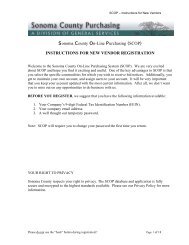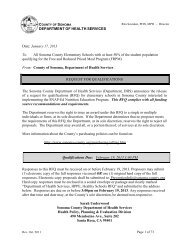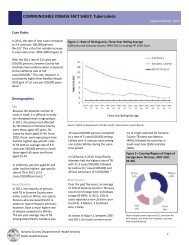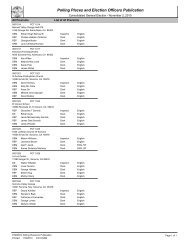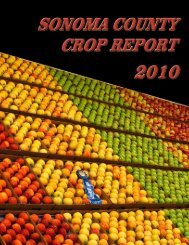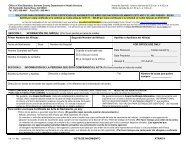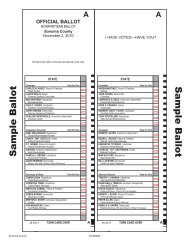Wine Industry Insider Report 2010 - Sonoma County
Wine Industry Insider Report 2010 - Sonoma County
Wine Industry Insider Report 2010 - Sonoma County
You also want an ePaper? Increase the reach of your titles
YUMPU automatically turns print PDFs into web optimized ePapers that Google loves.
EDB<br />
<strong>Sonoma</strong> <strong>County</strong><br />
Economic Development Board<br />
<strong>Wine</strong> <strong>Industry</strong> <strong>Insider</strong><br />
<strong>2010</strong><br />
E c o n o m i c D e v e l o p m e n t B o a r d 4 0 1 C o l l e g e Av e n u e S u i t e D S a n ta R o s a C A 9 5 4 0 1 ( 7 0 7 ) 5 6 5 - 7 1 7 0 www.<strong>Sonoma</strong>EDB.org
<strong>2010</strong><br />
<strong>Wine</strong> <strong>Industry</strong> <strong>Insider</strong><br />
April <strong>2010</strong><br />
The <strong>Sonoma</strong> <strong>County</strong> Economic Development Board (EDB), in partnership with the <strong>Sonoma</strong> <strong>County</strong> Workforce<br />
Investment Board (WIB), is pleased to bring you the <strong>2010</strong> <strong>Wine</strong> <strong>Industry</strong> <strong>Insider</strong> <strong>Report</strong>. Our research partner<br />
Moody’s Economy.com, produced this report for the EDB.<br />
Highlights from this report include:<br />
<strong>Wine</strong> grape production increased substantially at <strong>Sonoma</strong> <strong>County</strong>’s vineyards in 2009 after the<br />
drought-induced declines of the previous three years. Total grape tonnage increased 26% to one of<br />
the highest levels on record. The easing of drought conditions will set the stage for a second<br />
consecutive year of increased wine grape production in <strong>2010</strong>.<br />
The large grape crop in 2009 lowered the prices paid by processors for <strong>Sonoma</strong> <strong>County</strong>-grown<br />
grapes. Prices fell by 2%, in contrast to a slight overall increase for statewide wine grape prices. Prices<br />
for the county’s red wine varietals dropped by 2%, while white wine varietal prices declined by 1%.<br />
The growing association of <strong>Sonoma</strong> <strong>County</strong> as a top international wine-making area may help wine<br />
producers in the county to increase market share among core and international wine drinkers and to<br />
withstand additional flight to value among marginal wine consumers. Demographic trends suggest<br />
healthy longer-term prospects for the <strong>Sonoma</strong> <strong>County</strong> wine industry despite recent weakness. Core<br />
wine drinkers—those who consume wine at least weekly—helped to increase wine consumption in<br />
2009 despite reduced consumption of marginal wine drinkers.<br />
The recession and subsequent period of weak economic growth have driven wine drinkers toward<br />
more affordable wines at the expense of the higher-priced wines produced in <strong>Sonoma</strong> <strong>County</strong>. The<br />
above-average wine grape crop in 2009 further burdened wineries by adding to inventories. As a<br />
result, <strong>Sonoma</strong> <strong>County</strong> winemakers face the prospect of reducing prices to spur sales growth potential<br />
in <strong>2010</strong>.<br />
Thank you for your continued interest in Economic Development Board research. As always, if you have<br />
questions or suggestions, please feel free to contact us at (707) 565-7170.<br />
Sincerely,<br />
Ben Stone<br />
Executive Director<br />
©<strong>2010</strong> <strong>Sonoma</strong> <strong>County</strong> Economic Development Board. The Economic Development Board (EDB) believes all data contained within<br />
this report to be accurate and the most current available, but the EDB does not guarantee that this report is accurate or complete. This<br />
publication can be made available in alternative formats, such as Braille, large print, audiotape, or computer disk. Requests can be made<br />
by b calling (707) 565-7170. Please allow 72 hours for your request to be processed.
Moody’s Economy.com<br />
Recent Trends. <strong>Sonoma</strong> <strong>County</strong> winemakers are<br />
adapting to an altered marketplace. The recession<br />
and subsequent period of weak economic growth,<br />
combined with lagging improvements in the labor<br />
market, have driven wine drinkers toward more<br />
affordable wines at the expense of the higher-priced<br />
wines produced in <strong>Sonoma</strong> <strong>County</strong>. The aboveaverage<br />
wine grape crop in 2009 further burdened<br />
wineries by adding to inventories. As a result, <strong>Sonoma</strong><br />
<strong>County</strong> winemakers face the prospect of reducing<br />
prices to spur sales growth potential in <strong>2010</strong>.<br />
Production increased substantially at <strong>Sonoma</strong><br />
<strong>County</strong>’s vineyards in 2009 after the drought-induced<br />
declines of the previous three years. Total grape<br />
tonnage increased 26% to one of the highest levels on<br />
record. Production of red wine varietals, the county’s<br />
largest crop, increased by 22%, of which the largest<br />
varietal, cabernet sauvignon, increased by 30%. White<br />
wine varietals increased 32%; chardonnay production,<br />
which makes up most of the county’s white wine<br />
output, increased 37%.<br />
<strong>Wine</strong> consumption in the U.S. managed to<br />
grow in 2009 by 1.9%, according to Gomberg, Fredrikson<br />
& Associates. However, growth in consumption<br />
was achieved by the discounting of wines in all price<br />
ranges. Total sales of wine fell by 3.3% last year—the<br />
first decline since 1991.<br />
The changing consumption patterns of<br />
consumers also hit international wine markets. The<br />
value of exports of U.S. wines decreased by 15% last<br />
year—the first decline since 2005, according to the<br />
<strong>Wine</strong> Institute. Falling shipments to the European<br />
Union—still weighed down by recession and weak<br />
growth—contributed the most to the decline. Growing<br />
exports to Asia partly offset weakness in<br />
Europe—shipments to China and Japan increased<br />
15% and 18%, respectively.<br />
The value of U.S. wine imports declined 9% last<br />
year—the first drop in more than a decade—<br />
although the volume of bulk wine imports increased<br />
substantially by 24 million cases. As a result of the<br />
larger quantities of imports at lower prices, imported<br />
wines’ share of total U.S. sales volumes jumped to<br />
32.5%—the highest level on record.<br />
Macro drivers. The U.S. economy has emerged from its<br />
deepest recession since the Great Depression.<br />
2<br />
Falling Prices Keep <strong>Wine</strong> Sales Afloat<br />
www.sonomaedb.org<br />
Moody’s Economy.com • www.economy.com • help@economy.com • April <strong>2010</strong><br />
3.6<br />
3.5<br />
3.4<br />
3.3<br />
<strong>Wine</strong> prices, % change<br />
yr ago, 3-mo MA, ths (R)<br />
3.2<br />
Beer, wine and liquor store<br />
sales, $ ths, 3-mo MA (L)<br />
3.1<br />
07 08 09 10<br />
Sources: Department of Commerce, Department of Labor<br />
5<br />
4<br />
3<br />
2<br />
1<br />
0<br />
-1<br />
FROM MOODY’S ECONOMY.COM<br />
<strong>Wine</strong>ries that are able to compete on the terms of price will<br />
benefit from another year of price-conscious consumers. Falling<br />
prices in 2009 kept total U.S. wine sales positive last year.<br />
However, not all wineries were able to reduce prices and<br />
overhead and remain profitable—especially producers of highpriced<br />
wines in the North Bay. Access to lower-cost grapes will be<br />
a plus for wineries in the near term.<br />
Improving Incomes Will Free <strong>Wine</strong> Spending<br />
13.5<br />
13.0<br />
12.5<br />
12.0<br />
11.5<br />
U.S. savings, $ mil (R)<br />
U.S. personal income, $ tril<br />
11.0<br />
07 08 09 10E 11F<br />
Source: Department of Commerce, Moody’s Economy.com<br />
700<br />
600<br />
500<br />
400<br />
300<br />
200<br />
100<br />
FROM MOODY’S ECONOMY.COM<br />
The recovery of the U.S. economy will help <strong>Sonoma</strong> <strong>County</strong> and<br />
other producers of high-cost wines. During the recession, wine<br />
drinkers in all segments pursued lower-priced wines and<br />
discounted high-priced bottles. Job and personal income growth<br />
will reverse recent increases in savings in the near term, freeing<br />
pent-up demand for luxury goods. The pace of luxury spending<br />
will depend on the strength of the recovery.
Moody’s Economy.com<br />
Industrial production is on the rise, and gross domestic<br />
product has increased for two consecutive<br />
quarters—most recently by 5.5% in the fourth quarter<br />
of 2009. U.S. GDP is forecast to grow at 2.8% in <strong>2010</strong><br />
before strengthening to faster rates of growth in 2011<br />
and 2012.<br />
The labor market has lagged behind improvements<br />
elsewhere in the economy. The U.S. unemployment<br />
rate will peak above 10% by the end of the year<br />
before declining in 2011. As a result of remaining<br />
labor market weakness, personal income is forecast to<br />
grow at a rate below 2% this year.<br />
The health of U.S. consumers will improve in<br />
the near term but is still some distance away from a<br />
full recovery. Retail sales, consumer confidence, stock<br />
markets and house prices have all risen above the<br />
depths they reached during the recession, but remain<br />
below pre-recession levels. Similarly, household net<br />
worth has partly recovered the losses of the past few<br />
years.<br />
The edging-down of the savings rate in the<br />
first two months of <strong>2010</strong> to 3.1%—below the 3.9%<br />
average for the second half of 2009—could signal<br />
that more affuent consumers are positioned to act<br />
upon pent-up demand for luxury goods such as<br />
high-priced wine. However, expectations of weak-atbest<br />
economic and labor improvements weigh on any<br />
outlook for an end to consumers’ flight to value in the<br />
near term.<br />
<strong>Industry</strong> drivers. The easing of drought conditions will<br />
set the stage for a second consecutive year of<br />
increased wine grape production in <strong>2010</strong> for <strong>Sonoma</strong><br />
<strong>County</strong> grape growers. This winter’s close-to-average<br />
rainfall in <strong>Sonoma</strong> <strong>County</strong> to date comes after last<br />
year’s late but plentiful rains, which resulted in an<br />
increase in the yield of wine grape crops throughout<br />
California’s various wine-growing regions last fall.<br />
The easing of drought conditions will help<br />
wine grape growers cope with increasing limitations<br />
on water use—at least in the near term. Proposed<br />
state limits on the diversion of water from the Russian<br />
River and its tributaries for frost protection are open<br />
to review and public comments. If <strong>Sonoma</strong> <strong>County</strong><br />
were to return to drought conditions in the future,<br />
growers fear that the limitations will make them<br />
unable to fight off late spring frosts, exposing their<br />
grape crops to large losses.<br />
Moody’s Economy.com • www.economy.com • help@economy.com • April <strong>2010</strong><br />
The buyers’ market for wine will increase interest<br />
in direct marketing and sales channels to consumers<br />
in the near term. In 2009, three states dropped<br />
prohibitions against direct shipments, leaving only 12<br />
states with complete bans. The expansion of direct<br />
wine shipments to additional states offers a lucrative<br />
distribution channel for specialty winemakers in<br />
<strong>Sonoma</strong> <strong>County</strong> that lack the distribution infrastructure<br />
of large wine companies.<br />
Despite the dwindling number of remaining<br />
direct shipment bans, complex licensing regimes<br />
remain in most states, making direct shipments a<br />
costly undertaking, especially for new entrants.<br />
Amazon.com backed away last year from its plan to<br />
offer online wine sales. As a result, Amazon’s Napabased<br />
fulfillment and logistics partner, New Vine<br />
Logistics, liquidated its operations this past fall.<br />
With barriers to entry limiting growth of direct<br />
shipments, wineries will seek other direct outlets to<br />
reach consumers. Many wineries in California’s winegrowing<br />
regions have taken advantage of falling<br />
construction and land prices to expand their tasting<br />
rooms. In addition, a new law in California last year<br />
expanded the offerings and locations of secondary<br />
satellite tasting rooms—many of which are located<br />
outside the county in large urban metro areas such as<br />
San Francisco. New bottling and packaging technologies<br />
are allowing more wineries to produce sample<br />
packages—a low-cost way to extend their direct marketing<br />
appeals to additional consumers.<br />
Pricing. The shift to value by consumers and wine<br />
retailers will put downward pressure on wholesale<br />
wine prices for <strong>Sonoma</strong> <strong>County</strong> wineries in <strong>2010</strong>.<br />
Demand remains weak in the wholesale market for<br />
wine priced above $35 a bottle—a <strong>Sonoma</strong> <strong>County</strong><br />
specialty—while demand for bottles priced $20 and<br />
below is rising, to the benefit of lower-cost wine<br />
growers outside the county. The increased yield of the<br />
2009 grape harvest will add further to the downward<br />
trend in prices.<br />
Retail pricing will continue to favor producers<br />
and distributors of low-priced wines in <strong>2010</strong>. Early<br />
sales data for <strong>2010</strong> from Nielsen Co. reflect that sales<br />
of wine priced between $9 and $20 are contributing<br />
significantly to retail wine sales volumes. However,<br />
some hope for at least stability in <strong>2010</strong> sales<br />
www.sonomaedb.org 3
Moody’s Economy.com<br />
Low-Cost <strong>Wine</strong> Imports Will Gain Market Share<br />
Local currency per U.S. dollar, 2009Q1=100<br />
130<br />
120<br />
110<br />
100<br />
4<br />
90<br />
80<br />
09 10E 11F<br />
Source: Moody’s Economy.com<br />
Argentina Euro zone Chile China<br />
www.sonomaedb.org<br />
FROM MOODY’S ECONOMY.COM<br />
Imports of low-cost Argentine wines will gain additional<br />
market share in <strong>2010</strong> as a result of the weakening Argentine<br />
peso. In contrast, the strengthening Chilean peso and the loss<br />
of supply because of the major earthquake will limit imports of<br />
Chilean wine. The gradual weakening of the Chinese yuan will<br />
help increase the affordability of <strong>Sonoma</strong> <strong>County</strong> wine<br />
exports.<br />
Spring Rains Result in Increasing Grape Yields<br />
<strong>Sonoma</strong> <strong>County</strong> wine grape tonnage, % change yr ago, 2008<br />
Chardonnay<br />
Cabernet…<br />
Zinfandel<br />
Total<br />
Merlot<br />
Sauvignon…<br />
Pinot Noir<br />
Source: Moody’s Economy.com<br />
0 5 10 15 20 25 30 35 40<br />
FROM MOODY’S ECONOMY.COM<br />
Plentiful rainfall in the North Bay wine-growing area in the winter<br />
of 2009-<strong>2010</strong> will help keep the <strong>2010</strong> crop from declining too far<br />
below 2009 levels. Pinot noir had the smallest increase of<br />
<strong>Sonoma</strong> <strong>County</strong> wine grapes, reflecting declining interest by<br />
growers after several years of popularity. The increasing yield did<br />
lower prices, putting pressure on growers and wineries facing<br />
falling retail prices.<br />
Moody’s Economy.com • www.economy.com • help@economy.com • April <strong>2010</strong><br />
of the higher-priced wines can be found in recent data.<br />
Through the year ending March 6, the average retail sales<br />
price for a 750 ml bottle of wine increased by $0.07 from a<br />
year ago.<br />
Internationally, some wine-exporting countries<br />
such as Australia are coping with a drastic oversupply<br />
resulting from overinvestment that has driven down<br />
prices. To cope, many Australian growers are ripping out<br />
wine grape plants. In contrast, Chile suffered the loss of<br />
13% of its bulk, bottled and aging wine as a result of the<br />
major earthquake that struck the country in early <strong>2010</strong>.<br />
The losses, combined with damages to transportation<br />
infrastructure, will likely reduce supply in the near term<br />
and beyond, driving up prices for Chilean wines and<br />
reversing or slowing recent U.S. market gains in low-price<br />
categories.<br />
Operating expenses. The large grape crop in 2009<br />
lowered the prices paid by processors for <strong>Sonoma</strong><br />
<strong>County</strong>-grown grapes. Prices fell by 2%, in contrast to a<br />
slight overall increase for statewide wine grape prices.<br />
Prices for the county’s red wine varietals dropped by 2%,<br />
while white wine varietal prices declined by 1%.<br />
Labor costs will remain low for grape growers in<br />
the near term. The recession stemmed the outflow of field<br />
workers to other industries—in particular construction<br />
—eliminating worker shortages. In the early stage of<br />
recovery, <strong>Sonoma</strong> <strong>County</strong>’s unemployment rate is<br />
approaching 11%—its highest level in more than 20<br />
years. Job losses are forecast to ease in <strong>2010</strong> before<br />
decreasing at a sustainable level in 2011. The slow pace of<br />
improvement in the labor market will continue to limit<br />
alternative employment opportunities for field workers.<br />
With downward pressure on prices continuing in<br />
<strong>2010</strong>, wineries are unlikely to increase hiring in the near<br />
term. Employment at the county’s wineries trended<br />
downward through the first half of 2009, the latest period<br />
of detailed employment data available, amid cost-cutting<br />
by wine companies of all sizes.<br />
The outlook for operating costs will worsen for<br />
<strong>Sonoma</strong> <strong>County</strong> wineries in the near term. Improvements<br />
in the overall economy have helped fuel prices to partly<br />
recover from the lows reached last year, increasing operating<br />
costs for wineries. However, outside of food and<br />
fuels, price inflation has been largely absent. This has<br />
removed the ability for wine producers to pass along<br />
increased operating costs to consumers in the form of<br />
higher prices.
Moody’s Economy.com<br />
Profitability. The shift in consumer demand to inexpensive<br />
wines will keep pressure on the profits of high-end<br />
<strong>Sonoma</strong> <strong>County</strong> wineries that are geared toward highmargin<br />
restaurant sales. Overall sales of wine at restaurants<br />
fell between 6 and 9% in 2009 according to the<br />
<strong>Wine</strong> Institute, although the declines for mid- and highpriced<br />
wines ranged from 20 to 30%. For smaller wineries,<br />
the combination of falling sales and accumulating inventories<br />
has been damaging to their balance sheets. The<br />
number of defaults and foreclosures of wineries in the<br />
North Bay wine-growing areas surged last year.<br />
The lingering slump for high-priced wines will<br />
likely trigger a shakeout of winery ownerships in <strong>Sonoma</strong><br />
<strong>County</strong> and other high-priced California wine-growing<br />
areas. Falling profits and valuations of winery operations<br />
will push the smallest and most specialized operations<br />
out of business or make them candidates for acquisitions.<br />
<strong>Wine</strong>ries that manage to diversify their offeringsespecially<br />
with lower-cost wines or with wines grown in<br />
lower-cost areas—will be better positioned to maintain<br />
profit levels in the near term.<br />
The outlook for currencies from major wineexporting<br />
countries in <strong>2010</strong> offers a mixed picture for the<br />
handful of large volume <strong>Sonoma</strong> <strong>County</strong> wineries that<br />
export wine abroad. The U.S. dollar is expected to appreciate<br />
against the currencies of only two major wine<br />
exporters to the U.S.—Argentina and the European<br />
Union. This will help lower-priced wines from the former<br />
gain additional U.S. market share and make higher-cost<br />
wines from the latter more affordable. The dollar will lose<br />
value only relative to New Zealand, while maintaining<br />
value with the Chilean peso and the Australian dollar. This<br />
will help prevent or at least slow a surge in wine imports<br />
from these low-cost growing areas.<br />
Long-term outlook. Demographic trends suggest healthy<br />
longer-term prospects for the <strong>Sonoma</strong> <strong>County</strong> wine<br />
industry despite recent weakness. Core wine drinkers<br />
—those who consume wine at least weekly—helped to<br />
increase wine consumption in 2009 despite reduced<br />
consumption of marginal wine drinkers. The share of core<br />
consumers has risen from 2000 to 2009 after holding<br />
steady through the 1990s. Once the economy enters a<br />
full recovery, the buying power of core drinkers will<br />
improve, and wineries will once again be able to market<br />
more expensive wines to them.<br />
The trajectory of future wine drinkers to embrace<br />
high-priced wines will also benefit the <strong>Sonoma</strong> <strong>County</strong><br />
wine industry in the long term. Although the “millennial”<br />
Moody’s Economy.com • www.economy.com • help@economy.com • April <strong>2010</strong><br />
generation—the population cohort now aged 15 to 32<br />
—suffered reduced employment and income levels<br />
during the recession, they have embraced wine consumption<br />
at a faster rate than earlier generations and have been<br />
more willing to trade up to higher-priced wines. Fifty<br />
million millennials are of legal drinking age in the U.S., a<br />
number that will grow in the future, along with their<br />
income-earning potential.<br />
Upside risks. The growing association of <strong>Sonoma</strong> <strong>County</strong> as<br />
a top international wine-making area may help wine<br />
producers in the county to increase market share among<br />
core and international wine drinkers and to withstand additional<br />
flight to value among marginal wine consumers. The<br />
adoption of a proposed conjunctive labeling law similar to<br />
neighboring Napa <strong>County</strong> could help promote the county’s<br />
wines and also offer a marketing tie-in with its lucrative<br />
tourism industry. However, passage of the law is far from<br />
certain.<br />
Growing overseas markets—especially in Asia—<br />
offer the potential to offset still-weak demand for highpriced<br />
wines in the U.S. and Europe in the near term.<br />
Further depreciation of the dollar versus the Chinese yuan<br />
will increase the affordability of <strong>Sonoma</strong> <strong>County</strong> wines for<br />
the growing number of affuent Chinese consumers.<br />
Downside risks. A permanent or extended downward shift<br />
to value by wine consumers is the largest downside risk for<br />
<strong>Sonoma</strong> <strong>County</strong> winemakers. Even core drinkers have<br />
taken advantage of steep price discounting to purchase<br />
high-priced wines at a fraction of their normal retail or<br />
restaurant markups. Weak economic growth and a slowly<br />
recovering job market could make wine drinkers’ flight-to<br />
-value permanent, endangering the traditional marketing<br />
and distribution model embraced by producers of highpriced<br />
wines, which centers on perceptions of quality and<br />
relatively inelastic demand among the most affuent<br />
consumers.<br />
Similarly, a lack of diversification between highpriced<br />
and lower-priced wines would hinder <strong>Sonoma</strong><br />
<strong>County</strong>’s winemakers’ transition into a structurally changing<br />
wine market. Producers from lower-cost, wine-growing<br />
areas of California have been able to increase retail market<br />
share during the recession and the initial recovery period.<br />
They have also been able to capitalize on their pricing<br />
affordability in order to enter into new distribution<br />
channels—including national restaurant chains and<br />
airlines—that will increase their exposure to new wine<br />
drinkers.<br />
April <strong>2010</strong><br />
www.sonomaedb.org<br />
edb.org 55
EDB<br />
<strong>Sonoma</strong> <strong>County</strong><br />
Economic Development Board<br />
With Acknowledgment and Appreciation to Local Key Businesses<br />
Supporting <strong>Sonoma</strong> <strong>County</strong> Economic Development:<br />
Director<br />
Executive<br />
Sponsor<br />
<strong>County</strong> of <strong>Sonoma</strong> General Services, Real Estate Division <strong>County</strong> of <strong>Sonoma</strong> Board of Supervisors<br />
<strong>Sonoma</strong> <strong>County</strong> Health Services <strong>Sonoma</strong> <strong>County</strong> Transportation & Public Works<br />
www.sonomaedb.org




